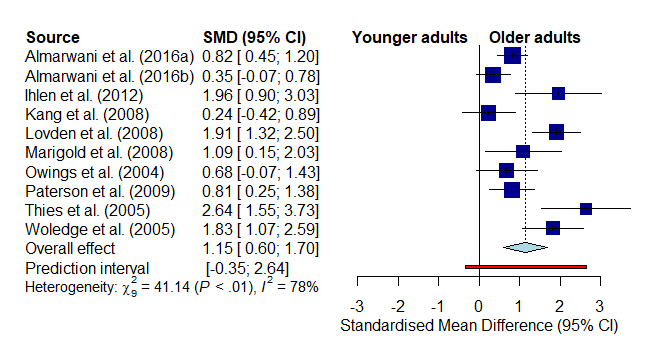By Andreas Skiadopoulos
Recent investigations have demonstrated that step width variability increases with age, which could be a signal of developing deterioration in gait stability. In the literature, step width variability has been extensively examined in an attempt to find which exercise-based interventions improve gait stability in older adults. However, it is not known when step width variability values in older adults should be considered as excessive. This is an issue of great importance as this information could be used to enroll participants who have the potential to benefit most from an intervention, tailor the intervention dose to match participant’s level of walking stability, and monitor or evaluate intervention effects. Thus, the main purpose of this systematic review and meta-analysis was to compare the amount of step width variability (expressed as the standard deviation of step width) between young and older adults and to identify the boundaries of optimal reference range of step width variability.
After screening 1408 studies from 11 databases we found 10 studies that met our criteria. We conducted a meta-analysis to compare the step width variability between older and younger adults (304 older adults and 219 younger adults). Additionally, a two-decision method was used on the meta-analytic data to identify optimal thresholds of step width variability to discriminate age-related gait changes. The results showed that older adults have greater step width variability than young adults (Figure). Step width variability values in older adults above the upper threshold value of 2.50 cm were considered excessive, while step width variability values below the lower threshold value of 1.97 cm were considered within the optimal reference range. For our purposes, the step width variability values in healthy young adults set the optimal reference range.
Based on our systematic review and meta-analysis, older adults with excessive step width variability form a plausible target population for effective exercises in preventing falls and lowering fall risk. Moreover, optimal thresholds levels of step width variability could potentially impact rehabilitation technology design for devices targeting lateral instability during walking.

Figure. Forest plot of standardized mean difference (SMD) and 95% confidence intervals (CI) for the step width variability between older and younger adults.
Publication
Skiadopoulos, A., Moore, E.E., Sayles, H.R., Schmid, K.K., Stergiou, N. Step width variability as a discriminator of age-related gait changes. J NeuroEngineering Rehabil 17, 41 (2020). https://doi.org/10.1186/s12984-020-00671-9
About the Author

Andreas Skiadopoulos
Department of Biomechanics and Center for Research in Human Movement Variability, University of Nebraska at Omaha, US
I am Research Associate in Biomechanics at the University of Nebraska at Omaha. I am investigating novel exercise interventions specifically designed to improve walking balance and prevent falls in older adults.
Copyright
© 2020 by the author. Except as otherwise noted, the ISPGR blog, including its text and figures, is licensed under a Creative Commons Attribution-ShareAlike 4.0 International License. To view a copy of this license, visit https://creativecommons.org/licenses/by-sa/4.0/legalcode.
ISPGR blog (ISSN 2561-4703)
Are you interested in writing a blog post for the ISPGR website? If so, please email the ISGPR Secretariat with the following information:
- First and Last Name
- Institution/Affiliation
- Paper you will be referencing


